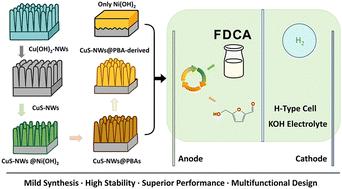Sulfur-modified copper nanowire substrate with Prussian blue analogue reconstruction: a dynamic electrocatalyst for biomass-derived HMF oxidation†
IF 4.2
3区 化学
Q2 CHEMISTRY, PHYSICAL
引用次数: 0
Abstract
This study reports a non-precious electrocatalyst, CuS-NWs@PBAs (copper sulfide nanowires functionalized with Prussian blue analogues), for the efficient oxidation of biomass-derived 5-hydroxymethylfurfural (HMF) to 2,5-furandicarboxylic acid (FDCA) under mild conditions. The catalyst was synthesized via a three-step electrodeposition process on a sulfurized copper foam substrate, where sulfurization enhanced substrate conductivity, reducing charge-transfer resistance by 90% compared to unsulfurized counterparts. Operando Raman and XPS spectroscopy revealed that the dynamic reconstruction of PBAs into NiOOH/Ni(OH)2 during alkaline activation created porous architectures with optimized Ni coordination environments, significantly lowering the energy barrier for the rate-determining FFCA → FDCA step. The optimized catalyst achieved 99.8% HMF conversion and 95.2% FDCA yield at room temperature with a low overpotential (0.35 V vs. HgO) and Tafel slope, outperforming most reported noble-metal systems. Systematic electrochemical analysis demonstrated high faradaic efficiency (>93%) and selectivity for the HMF → FDCA pathway, while control experiments validated the critical role of sulfurization and PBA reconstruction. Furthermore, the catalyst exhibited dual functionality in glycerol and urea oxidation, suggesting broader applicability. This work provides mechanistic insights into the dynamic evolution of transition metal catalysts and offers a practical strategy for designing cost-effective electrocatalysts for sustainable biomass valorization.

硫修饰铜纳米线衬底与普鲁士蓝模拟重建:生物质衍生HMF氧化的动态电催化剂†
本研究报道了一种非贵重电催化剂CuS-NWs@PBAs(用普鲁士蓝类似物功能化的硫化铜纳米线),用于在温和条件下将生物质衍生的5-羟甲基糠醛(HMF)有效氧化为2,5-呋喃二羧酸(FDCA)。该催化剂通过三步电沉积工艺在硫化泡沫铜衬底上合成,其中硫化增强了衬底的导电性,与未硫化的衬底相比,降低了90%的电荷转移电阻。Operando Raman和XPS光谱显示,在碱性活化过程中,PBAs动态重构成NiOOH/Ni(OH)2,形成了具有优化Ni配位环境的多孔结构,显著降低了决定速率的FFCA→FDCA步骤的能垒。优化后的催化剂在室温下的HMF转化率为99.8%,FDCA收率为95.2%,过电位低(0.35 V vs. HgO), Tafel斜率低,优于大多数已报道的贵金属体系。系统的电化学分析表明,HMF→FDCA途径具有较高的法拉第效率(>93%)和选择性,而对照实验则验证了硫化和PBA重构的关键作用。此外,该催化剂在甘油和尿素氧化中表现出双重功能,表明其具有更广泛的适用性。这项工作为过渡金属催化剂的动态演变提供了机制见解,并为设计具有成本效益的可持续生物质增值电催化剂提供了实用策略。
本文章由计算机程序翻译,如有差异,请以英文原文为准。
求助全文
约1分钟内获得全文
求助全文
来源期刊

Catalysis Science & Technology
CHEMISTRY, PHYSICAL-
CiteScore
8.70
自引率
6.00%
发文量
587
审稿时长
1.5 months
期刊介绍:
A multidisciplinary journal focusing on cutting edge research across all fundamental science and technological aspects of catalysis.
Editor-in-chief: Bert Weckhuysen
Impact factor: 5.0
Time to first decision (peer reviewed only): 31 days
 求助内容:
求助内容: 应助结果提醒方式:
应助结果提醒方式:


